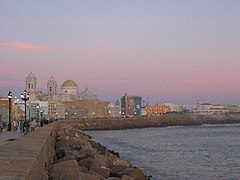| Cadiz | |
 | |
| Arms | |
.svg/120px-Escudo_de_Cádiz_(oval).svg.png) | |
| Map | |
 | |
| Information | |
| Country | Spain |
| Region | Andalusia |
| Surface | 12.10 km² |
| Population | 120 000 |
| Postal Code | 11000 |
| website | |
Cadiz - a city in the south-west Spainin the region Andalusia, the capital of the province of Cadiz. It is situated on a peninsula that separates the Gulf of Cadiz from the Atlantic Ocean.
Characteristic
Port and trading town, shipyard, metal and food industry. Colleges, museums, a famous tourist destination. The oldest city in Spain. The people of Cadiz are called Gaditano.
Drive
By plane
Jerez de la Frontera Airport is located 42 km northeast of Cadiz. It mainly serves low-cost airlines and charter flights.
There is also a train station on the line next to the airport Seville-Cadiz. The travel time by train, depending on the type, ranges from 50 minutes to 1 hour.
By rail
Cadiz is the terminus on the line from Seville. Trains from Madrid.
By car
Cadiz is reached by the AP-4 motorway from Seville. A new bridge across the Bay of Cadiz into the city has recently been opened Puerto Real, shortening the trip by several minutes.
Tongue
Communication
Worth seeing
- Cathedral, Parroquía de Santa Cruz, the former Renaissance church of Sagrario.
- Cathedral, Catedral Nueva, from the 18th and 19th centuries, with the tomb of Manuel de Falla and a museum with valuable monstrances (including the 4-meter Custodia de Millón by Antonio Suárez). The construction of the cathedral was started on the basis of a design by Vicent Acer, and due to financial reasons, it was completed only in 1853 - therefore the building mixes baroque and neoclassical elements. The interior is divided by huge Corinthian columns into three aisles, a transept and side chapels. The choir in the nave, made of mahogany wood by Augustin de Perei in 1697, comes from Cartuja de las Cuevas in Seville.
- Church of Oratorio de San Felipe Neri built in the years 1679–1719, where the Cortes were debating in the years 1811–1812. The fruit of these deliberations was the first liberal constitution of Europe, adopted on March 19, 1812, and annulled in 1823 by Ferdinand VII. Inside the church is a painting of the Immaculate Conception (Inmaculada) by Murilla. Next to the church there is a municipal museum (Museo Municipial), the collection of which includes, among others, the model of the city of Cadiz was created between 1777 and 1779 containing the original design of the church.
- Church of the Oratorio de la Santa Cueva built in the 18th century according to a design by Torcuato Cayón by Torcuato Benjumeda. Inside, there are three frescoes painted in 1796–97 by Francisco Goya - The Last Supper, The Miraculous Multiplication of Bread and Fish and the Parable of the Guest Without Wedding Garments.
- Defensive walls from the 17th century with the Puerta de Tierra gate, decorated with the coat of arms of Castile. On the sides of the gate, on high columns, there are figures of the patrons of the city of St. Servandus and St. Germanus
- Museum, in a former Franciscan monastery, with archaeological collections from Phoenician and Roman times, and the most important painting gallery after Seville.
- City museum Museo de Cadiz located in Plaza de Mina. On the ground floor, an exhibition showing the history of the city, on the upper floors, a painting gallery with works by, among others, Rubens, Murill and Zurbarán.
Nearest neighborhood
work
Science
Shopping
Gastronomy
Festivals, parties
Accommodation
- Hotel Regio Cádiz, 3-star hotel
- Hotel Patagonia Sur 3-star hotel
- Hotel Monte Puertatierra 4-star hotel
- Hotel Boutique Convento Cádiz 1-star hotel
- Apartamentos Plaza de la Luz Cádiz
- Casa Palacio Cádiz
contact
Security
Tourist information
Trip
| This is outline article. For now, it includes the article schema and not much else. You can help by supplementing the article with at least basic information, making it useful. |

